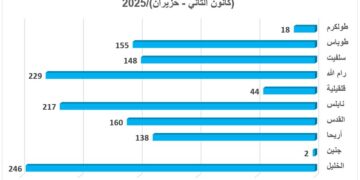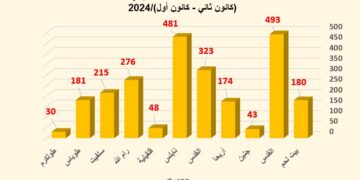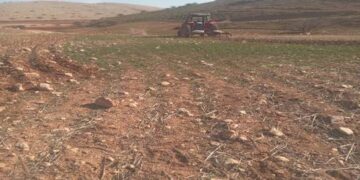- Violation: cutting and stealing a metal fence.
- Location: the village of Farata / Qalqilya Governorate.
- Date of Violation: 16/11/2020.
- Perpetrators: settlers of colonial outpost of “Hafat Gilad”.
- Affected people: Farmer Abdul Karim Abdullah Al-Taweel.Violation details:
During the night of 16 November, 2020, a group of settlers from the colonial outpost of “Hafat Gilad” infiltrated towards the lands of the eastern village of Fara’ta, and reached the area of Wata’t Sura, which is located no more than 200 meters away from the village homes. The colonists took advantage of the cold weather and the lack of farmers’ presence in the place to dismantle and steal a 90-meter-long metal fence that surrounded a part of Abdul Karim Abdullah al-Taweel’s two-donum land, which was newly planted with some fruit trees, figs and olives at the age of three years.
Photos 1-4: farmer Abdul Karim is re-installing a new fence in place of the one stolen by the colonialists to protect his land
It is noteworthy that the farmer fenced off the land at the beginning of the current year 2020 to protest it from wild pigs which were brought to the area by Israeli settlers as part of their terrorist acts aimed at frighteningly local communities and destroying their agricultural land.
According to the testimony of the affected citizen, during the past few months the presence of settlers in the area has repeated, and they have tried many times to restrict the farmers’s activity there, as the colony of “Hafat Gilad” is actually located only about 800 meters away from the land that was attacked, and there are also frequent threats from the colonists. All these atrocities aim at seizing as much land as possible in order to expand the borders of that outpost.
During the past five years, as an example, the field research team at the Land Research Center monitored a large number of violations committed by the settlers living in that outpost, including cutting, burning and stealing olive trees and their fruit and vandalizing Palestinian property. Although the perpetrators of these attacks are very well known to the Israeli police, they take no measures against, as every time the case i registered against an unknown person.
In the summer of 2018, colonialists began razing large areas around the colonial outpost in order to expand its borders by annexing more lands from the villages of Farata and Amatin.
Fara`ta village:
The village of Farata is located 26 km from the eastern side of the city of Qalqilya. It is bordered on the north by the village of Jet, on the west by Imatin, on the east Tal, and on the south by Imatin. Its population is 872 according to the census of 2017. Its total area is 1,657 dunums, of which 84 dunums are built up for the village of Jalameh.
* 188 dunums of Fara’ta village land were confiscated for the construction of bypass colonial road number 596.
* In case the 668m long scheme of the Apartheid Wall is implemented there it will seize 69 dunums and isolate 66 dunums .
Classification of Fara’ta village lands according to the Oslo Agreement:
Areas classified as A (NA) dunums.
Areas classified as B (1,493) dunums.
Areas classified (C) 164 dunums.
The colony of ‘Havat Gilad’ in brief:
It is noteworthy that the origins of these settlers go back to being the descendants of the colonizer “Zohar”, who is the chief settler in the West Bank. They brought a large number of extremist settlers from the colony of “Kiryat Arba” towards the colonial outpost to form gangs attacking farmers in the aforementioned villages. It should be noted that about 12 years ago, a number of settlers seized, with the support of the Israeli army, a large area of the lands of the villages (Fara’ta, Imatin, Sarra, Tal), in order to establish the nucleus of the colonial “Havat Gilad”, which soon expanded day after day. More of the lands of those villages were devoured to form at a later time a large Israeli colony, called the ‘Hafat Gilad’ farm, where the journey of continuous suffering of the people of the neighboring villages began and still going on in many forms.
The Land Research Center
LRC

















